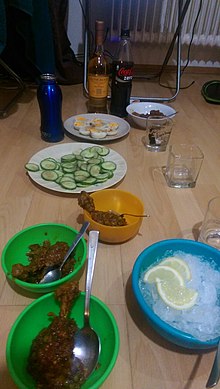
Tripe is a type of edible lining from the stomachs of various farm animals. Most tripe is from cattle, pigs and sheep.

Offal, also called variety meats, pluck or organ meats, is the organs of a butchered animal. The word does not refer to a particular list of edible organs, which varies by culture and region, but usually excludes muscle. Offal may also refer to the by-products of milled grains, such as corn or wheat.
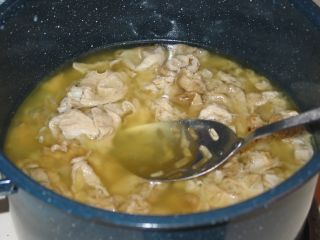
Chitterlings, sometimes spelled chitlins or chittlins are the small intestines of domestic animals, especially when cooked and eaten. They are usually made from pigs' intestines. They may also be filled with a forcemeat to make sausage.

In Mexican cuisine, Menudo, also known as pancita or mole de panza, is a traditional Mexican soup, made with cow's stomach (tripe) in broth with a red chili pepper base. Hominy, lime, onions, and oregano are used to season the broth.

Tripe soup, tripe stew or tripe chorba Macedonian: чкембе чорба) is a soup or stew made with tripe. It is widely considered to be a hangover remedy.
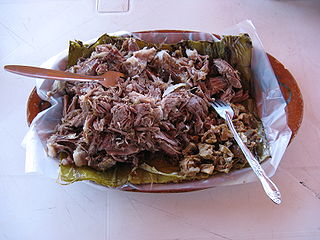
Barbacoa is a form of cooking meat that originated in present day Dominican Republic with the Taíno people, who called it barbaca, from which the term "barbecue" derives. In contemporary Mexico, it generally refers to meats or whole sheep or whole goats slow-cooked over an open fire or, more traditionally, in a hole dug in the ground covered with agave (maguey) leaves, although the interpretation is loose, and in the present day may refer to meat steamed until tender. This meat is known for its high fat content and strong flavor, often accompanied with onions and cilantro.

Khash is a dish of boiled cow or sheep parts, which might include the head, feet, and stomach (tripe).

Sancocho is a traditional broth in several Latin American cuisines. Variations represent popular national dishes in Puerto Rico, Honduras, Ecuador, Colombia, Cuba, Panama, Dominican Republic, Trinidad and Tobago, and Venezuela. It usually consists of large pieces of meat, tubers and vegetables served in a broth.

Kare-kare is a Philippine stew that features a thick savory peanut sauce. It is generally made from a base of stewed oxtail, beef tripe, pork hocks, calves feet, pig's feet or trotters, various cuts of pork, beef stew meat, and occasionally offal. Vegetables, such as include eggplant, Chinese cabbage, or other greens, daikon, green beans, okra, and asparagus beans, are added. The stew is flavored with ground roasted peanuts or peanut butter, onions, and garlic. It is colored with annatto and can be thickened with toasted or plain ground rice. Variations of kare-kare can be made with seafood, such as (prawns, squid, and mussels, or exclusively from vegetables.

Pörkölt is a meat stew which originates from Hungary, but is eaten throughout Central Europe.
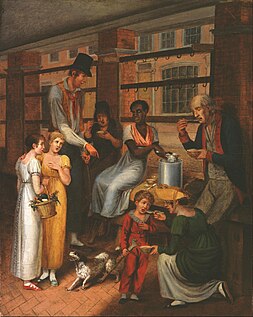
Pepper Pot is a thick stew of beef tripe, vegetables, pepper and other seasonings. The soup was first made in West Africa and the Caribbean before being brought to North America through slave trade and made into a distinctively Philadelphian dish by colonial Black women in the 19th century. It was one of the first street foods, sold by so-called "Pepper Pot women" and was at one point the symbolic food of the city, much like the cheesesteak today.

Ghanaian cuisine is the cuisine of the Ghanaian people. Ghanaian main dishes are organized around a starchy staple food, which goes with a sauce or soup containing a protein source. The main ingredients for the vast majority of soups and stews are tomatoes, hot peppers and onions. As a result, most of the Ghanaian soups and stews are red or orange in appearance.
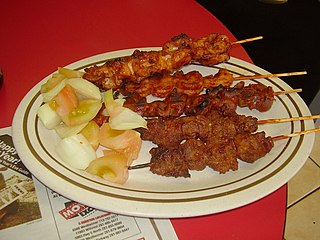
Nigerian cuisine consists of dishes or food items from the hundreds of ethnic groups that comprise Nigeria. Like other West African cuisines, it uses spices and herbs with palm or groundnut oil to create deeply flavored sauces and soups.

Gopchang-jeongol (곱창전골) or beef tripe hot pot is a spicy Korean stew or casserole made by boiling beef tripe, vegetables, and seasonings in beef broth. Gopchang refers to beef small intestines, while jeongol refers to a category of stew or casserole in Korean cuisine. Although the dish is mainly based on beef gopchang, other parts of beef innards are also used to give the dish a richer flavor and chewy texture.
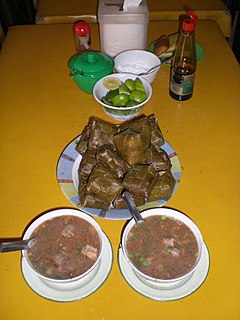
Coto Makassar or Coto Mangkasara (Makassarese), is an Indonesian traditional soup originating from Makassar, South Sulawesi. It is a variant of soto traditional beef and offal stew with seasoned broth made from ground peanuts and spices. The main ingredient of this soup is beef and it can be mixed with innards such as intestine, liver, lungs, heart, tripe, or cow brain.
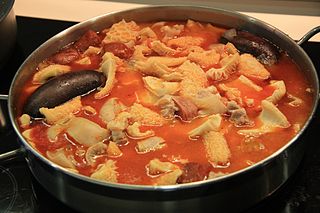
Callos is a stew common across Spain, and is considered traditional to Madrid. In Madrid, it is referred to as callos a la madrileña.

Paklay refers to two different Filipino braised dishes from the Mindanao and Visayas Islands characterized by julienned ingredients. They are eaten with rice or served as pulutan with alcohol.
